Week 99 - Disaster strikes with a flotilla
Ithaca and the joys of flotillas aboard Matilda exploring Greece.
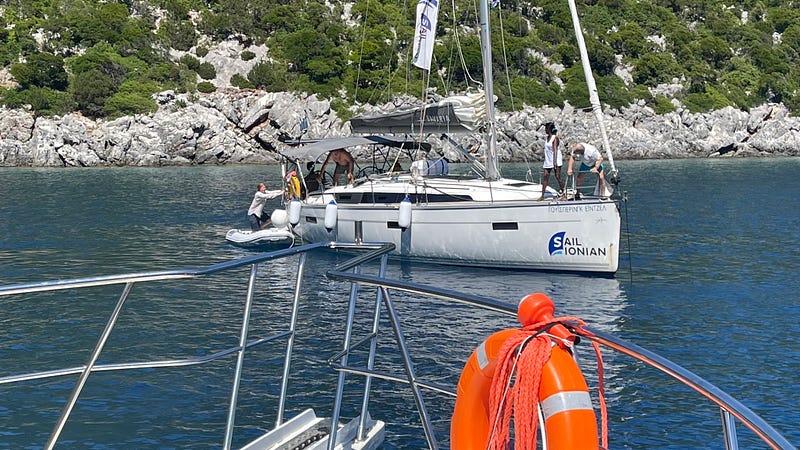
Ithaca and the joys of flotillas aboard Matilda exploring Greece.
On Friday night we were finally back on land enjoying dinner and we looked at each other and said “I’m looking forward to a break from the boat.” It felt good to admit that and the sentiment really sums up the week that we’ve had. On the whole the days and hours are great, but there’s been a few minutes in there that really sucked.
It seems a bit conceited to NOT always enjoy the lifestyle. After all, we are experiencing amazing scenery, crystal clear water and a fantastic culture, but sometimes, things can really go wrong and it’s hard to stop and take in the scenery while everything is rapidly going south. It’s amazing how the time between “having a great time” and “oh shit” can literally be measured in minutes or even seconds too.
The week started simply enough. We cruised back to Sami, Kefalonia on Monday morning and hired a car. As we pulled in, the boat next to us just watched us dock and then as we were trying to get the passerelle down to get off to shore so we could take our own lines, they finally decided to offer some assistance. They were new boaters, so didn’t quite have the etiquette down yet, that’s OK, but it was already a small teaser as to the way the week was heading. They were also spitting raw sewerage straight over the side, which when I pointed it out they just shrugged and said they didn’t know how to work the toilets properly and they were leaving anyway so no worries. 🤮

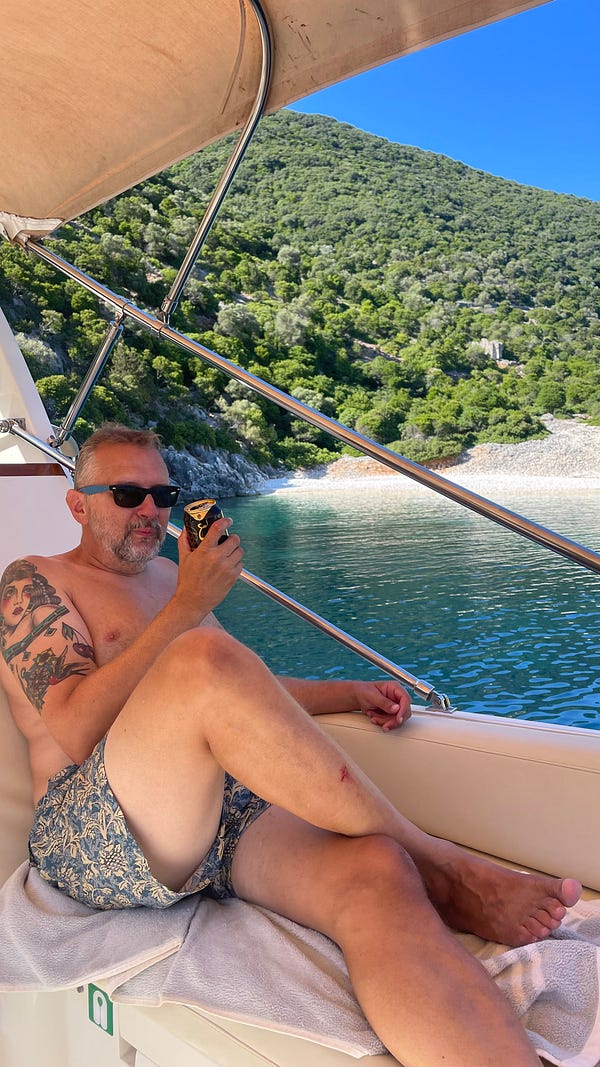
With car rented (€60 for a half day — they are getting more expensive!) we drove across Kefalonia to Argostoli to collect my new sunglasses. From there we toured the island and drove up the northern side of the west coast past Myrtos Beach and Asos. Kefalonia really is a beautiful place with some amazing scenery and some of the most azure blue water I’ve ever seen — it’s almost fluorescent. We enjoyed cruising around, you definitely see a different side of the island from the land and it’s good to see what else is on offer beside the beaches.
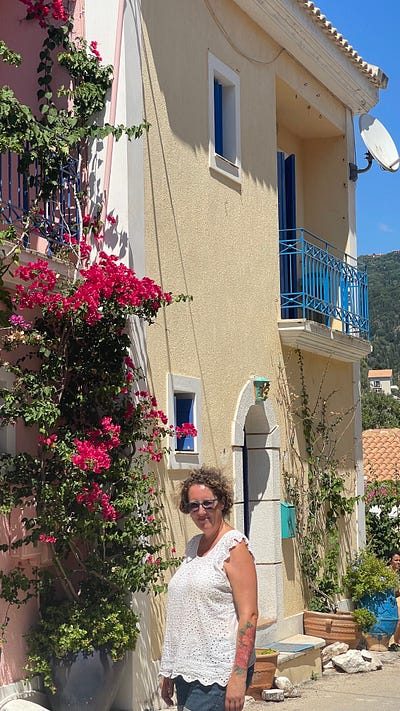
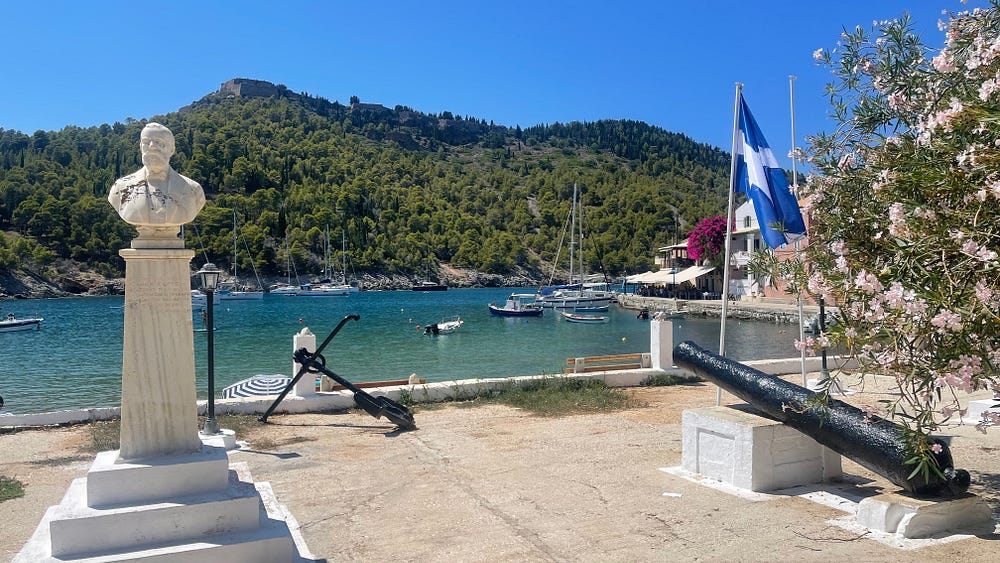
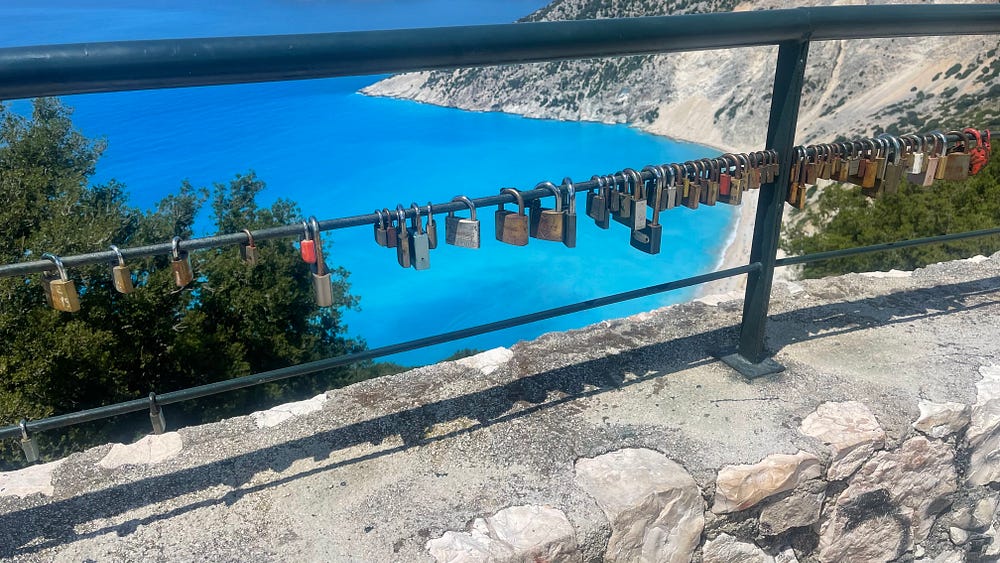
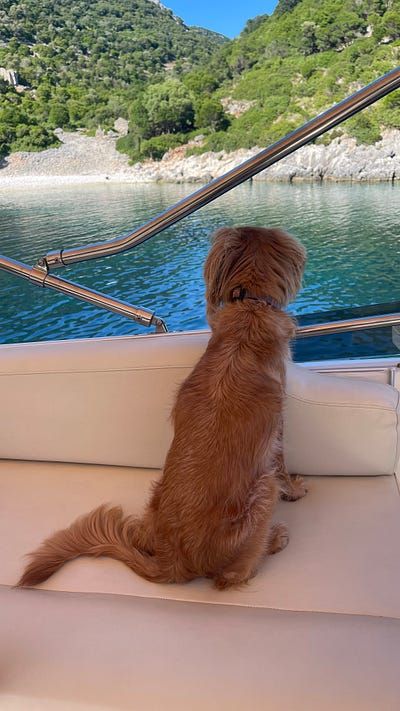
Tuesday morning it was a quick visit to the Drogarati Cave, which was OK, but nothing special. More “something to do” than a “must see”. We picked up a joint ticket when we saw the Mellisani Cave the week before so figured we may as well use the second half. At some point in its past they cleared the bottom of the cave and decided to use it as a “natural” theatre for shows, so it’s dramatic in scale, but also heavily damaged.


After far too many nights in ports, it was time to head for some crystal clear water again and get away from civilisation a bit, so we set off for Anti-Samos Bay (too crowded) and then crossed to Ithaca and Antri Bay on the southern side. It’s a very peaceful location, a deep, sheltered bay with a small beach at one end, a couple of ruined houses and goats that come down to the beach to drink seawater (TIL that goats can drink sea water).
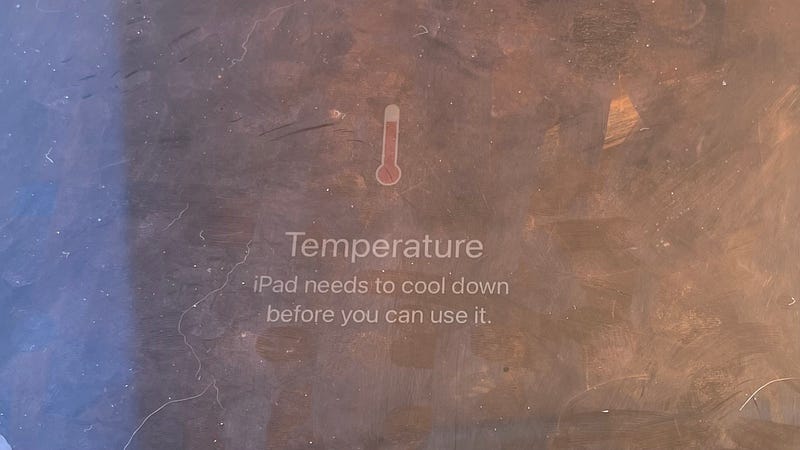
I need to set the scene a little — picture the bay as being a somewhat square sided U shape. There’s room at the bottom of the U for five or six boats to tie “stern to”. When they do this, they’ll drop their anchor in the middle of the U in front of their boat, reverse down and tie the stern of the boat to the land. This stops the boat swinging in the wind and lets more boats “pack” in. It’s very common here. We’re not that experienced with it to be honest, we’ve only done it two or three times before although we have everything we need on board to make it happen.
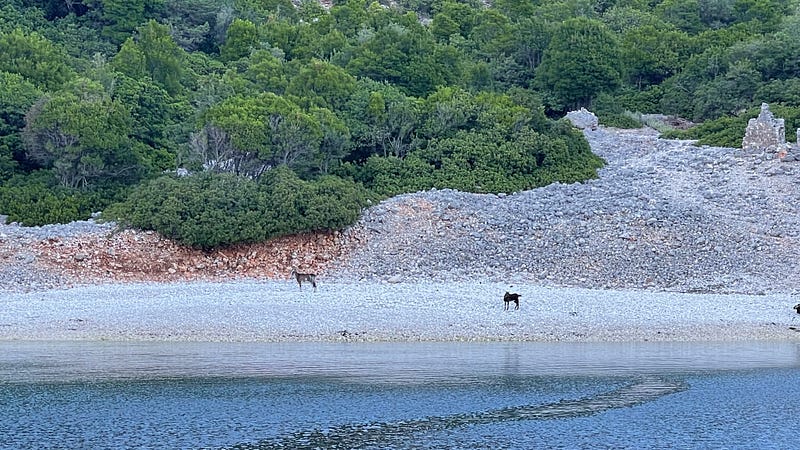
If the bottom of the U is full, then boats start going stern to along the sides — which stretch out maybe 200 meters toward the open sea. Of course, if you tuck in TOO tight to the corner, then when you drop your anchor to the middle of the U, you’ll cross the anchors of the people at the bottom. It’s hard (impossible) to know just how much chain that the people on the bottom of the U have deployed, but it’s a safe bet it’s at least 50 meters worth.
Then you have “day trippers” or “lunch stopovers” — typically charter boats these come in and want to stay for 2–3 hours to enjoy lunch and the scenery before moving on, they typically just come in, drop their anchor in the middle and stay. Of course when the anchorage is full, inevitable they drop their anchor over the top of someones anchor. If they are lucky, they can pull it up OK, but often when the wind picks up, their boat drags and the anchor is pulling along the bottom of the bay as they try to raise it, catching on the chains of the boats to shore.

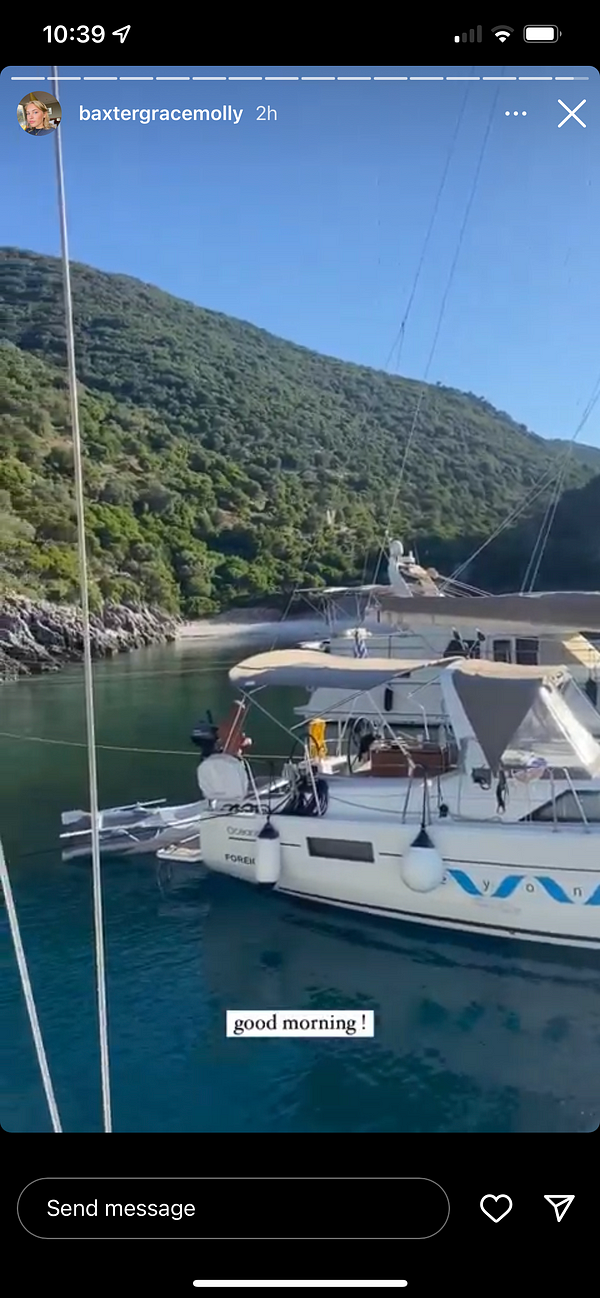
OK, scene is set!
We back down on the side of the U and tie off stern to. We’re close to the boats at the bottom but I figure just far enough out to be OK (we crossed one anchor but negotiated we’d leave before them so should be fine). A series of boats then come in and drop their anchors in the middle while they stop for lunch.
When one of the boats tries to leave, their windlass failed and they couldn’t raise their anchor. After watching them struggle for a good 20–30 minutes, I asked if they would like some assistance and received a grateful “yes please”, in response. So I swam out and helped them get unstuck.
It’s interesting to reflect on what the real issue was. Sure the windlass was broken but really their problem was that there was no hierarchy on the boat — everyone had 3 different ideas on how to fix it and they were working against each other to try and make it happen. They came very close to the solution at one point, but then the person who’s idea it was (one of the ladies aboard I believe) got bullied out of it and things were going downhill from there. I made it clear that I’d help but they needed to listen to me — which I agree can seem a little aggressive, but someone had to to take charge and give them some direction. It’s a good reminder again for us that boats NEED to have someone responsible, you can’t solve problems in an emergency situation as a democracy (doesn’t mean you can’t take ideas, but you do have to Stop, Think, then Act, not debate endlessly).
While it took another 30 minutes or more to get them free, it was a straight forward enough solution — get a spare rope, tie it to the chain, run the rope back to the winches in the cockpit, pull the anchor up.
In the process of all of this, their anchor dislodged ours and we started to drift backwards towards the rocks. Karina simply started the engines and put them to idle forward in gear which pulls the boat tight agains the ropes tied to the shore and held us in place. Then we release our anchor chain to give the people hooked some slack and pull their anchor to the top, release our chain and off they go. We scored a nice bottle of wine for the assistance too!
Sometimes you’re able to reset your anchor, but as ours had now been walked all over the bay, we had little choice but to slip the stern lines and reset (haul up our anchor and drop it again). We decided this time to go to the bottom of the U in the corner as this had cleared out as other boats left.
We were very happy with the new location — we’d put out even more chain (nearly 60 meters) and it was holding tight. What’s interesting about the weather patterns on these islands is that in strong winds (20+ knots) they don’t really protect you that well from the gusts — the wind hugs the hills and comes screaming down the gullies over the beach, so you need two things — a well set anchor and you need to have your stern lines fairly wide to the side of the boat to pull on the stern as the gusts push you around.
As dusk was falling another boat came in and tried to come in along side us, but with the gusts they couldn’t control the boat. The came close to hitting us, then eventually decided to give up and go. As they left, the gusts push them sideways out over our anchor chain and because their anchor was loose on the ground it dragged and caught our chain. We were experts at this now! So we started the engines, idled forward, gave them some slack and thankfully they were able to get free. Luckily this time, we were able to pull on our chain and at about 50 meters it reset itself and hooked in, no need to leave.
At this point this is really just (hopefully) interesting story of the things that happen during the week. While it’s an annoyance, we understand that anchors do get hooked up. Yes, it can be avoided, but as we get further into the Ionian and prime tourist and charter season, there’s a lot of boats out and about all trying to go to the same places. The first boat in particular were obviously learning, they accepted the help and they got free. The second boat tried something that was probably a little ambitious, but again, not going to blame them for trying.
No, the blame comes later in the week.
We spent a very peaceful Wednesday at anchor stern to in Antri as well, we had a good spot so why move! It was enjoyable, there was internet and there was great swimming. This is the life! No need to rush, just relax and enjoy the scenery.
There were no specific plans for Thursday, we’d been thinking maybe we’d relocate somewhere else, but then we got a message from Kerry and Keven who we met the week before saying they were planning to come to Antri as well, so we decided why not, we’d stay the extra day, meet up with them and have a drink. When you spend a lot of time on a boat together, it’s always fun to socialise in short bursts with new interesting people.
They pulled in next to us which we were very pleased about, not only because we could yell across to them and chat, but also because we thought it would prevent another boat trying to squeeze in. Then the flotilla arrived.
Whenever you chat to other live aboards, they all pretty much say the same thing. “We hate flotillas”. We had yet to really experience one before Thursday afternoon.
So what’s a flotilla? Typically when you have just received your first ever sailing certificate and you’ve never chartered before, the charter company will put you together into a flotilla with a designated fleet captain. Or maybe you want to join a flotilla — make some friends during the week and basically leave the decision making to the fleet captain. This is the important distinction — it’s not only (generally) a group of inexperienced captains, it’s a group of inexperienced captains under the instruction of a fleet captain. The fleet captain decides where you go, instructs you where to anchor, and assists in the process.
This is what makes them difficult to deal with. A very inexperienced captain pulled in alongside us — now there were several things wrong with how they were setup, but unlike your typical novice sailor, who’s usually very willing and open to advice, they felt their hands were tied as the fleet captain had instructed them to go there. We’d tried to communicate with the fleet captain, but he had no interest in talking with us, there were 10 boats to fit into a tight bay and he was going to make it happen.
So you’re left in the situation where a poor decision has been made, but it’s out of the hands of the novice captain and the person who has the authority is off running away compounding the problem cramming more boats in.
Nine times out of ten, it might have been fine — but after three days we knew with the conditions forecast the winds were going to pick up strongly and blow down the gully, the boat next to us was going to hit us. To make matters worse, when they dropped their anchor (in the spot as instructed by the fleet captain) it was over Kerry and Keven’s boat.
Sure enough, the wind picks up, the boat loses its holding and starts pushing onto our long line, then eventually on to our boat. The novice captain didn’t want to act without instruction from the fleet captain who was off chasing other boats with issues in the big winds. By the time the fleet captain returns, it’s beyond recovery — our boat has lost its anchor as well and is drifting sideways towards a superyacht. He instructs the boat to pull out, which they do, and as that happens they catch Keven and Kerry’s anchor and their boat start drifting back towards the rocks in the high winds. They were not yet aboard their boat, so it was a bad situation for them.
The days and hours have been great, but the minutes suck. 10 minutes before, Keven and Kerry were aboard Matilda, we were enjoying a chat and a drink, then the wind kicked up and the boat started drifting into us. Keven says ‘It’s lucky you had those fenders out”. Luck had nothing to do with it — we’d been telling the fleet captain this is EXACTLY what was going to happen. As we saw it getting worse, I said to him, “my next prediction is he leaves and pulls your anchor”.
There was also a catamaran, part of the charter fleet, trying to fit its way in to the left of their boat as well, and it was starting to drift into it.
Keven says, “I better get back there then” and by the time he and Kerry reached their boat, the anchor was adrift and they saved it from hitting the rocks only by shoving their tender in behind the boat before they could jump on board and start the engines. Unfortunately they don’t have floating lines and one line caught up in a prop which also caused a lot of other issues for them too.
At this point we forget about everyone else and Karina and I now move into “save Matilda” mode. We’re drifting sideways and we have to get into action fast. Starting her up, Karina goes on to the helm and starts to take Matilda out while I swim ashore to release the lines. The dog’s barking, everyone is shouting and it’s an intense, stressful situation. I’m trying to call instructions to Karina from the water, she’s trying to deal with things that she can see but I can’t and it’s all in all a fairly dangerous situation. We’ve got boats with limited control and a jammed prop, boats with novice skippers in high winds, people in the water trying to free lines, dogs (Rosie) barking, superyacht crew shouting and tenders ripping everywhere trying to help.
Five minutes later and we’re out of the worst of it, ten minutes later we’ve retrieved our anchor and then we just bug out of there.
The adrenaline is pumping. We both feel exhausted and we’re just happy we’ve escaped intact without any damage. Outside the bay, we stop and pause and try to take a moment to reset. Everything is all over the place — instead of our typical orderly and organised departure, lots of things haven’t been done properly. As waves hit the front of the boat, we remember we forgot to close the front hatch which we promptly get sorted. We’re having to make decisions on the fly and decided as dusk is approaching, where to now?
We pick a spot and the we both pretty much collapse into the seats and process what happened as we make our way to the new location.
When we arrive, we’re very happy there’s a good looking spot still available next to a giant super yacht and we drop the anchor, reverse in, then grab the stern lines, which we’d left tangled up on the deck and start feeding them back out over the stern.
It’s here I realise I’ve made a terrible mistake.
We use floating lines to avoid them getting caught in the propellor. Usually I’d have them set on the deck so that I can take one end, pull it with me and swim to shore. We then use a tow strap / snatch strap to wrap around the rocks so that the lines don’t get damaged and then tie the ropes to the tow strap. When we’d pulled the lines in, I just shook the tow straps off, I never undid the line and we’d dragged them back onto the boat like that— we’d changed our operating procedure without thinking about it.
Tired, stressed and honestly still angry at what had happened, I fed the lines back in to the water, with the tow strap still attached — if anything I was day dreaming about how nice it was going to be to be tied back safely to shore and relaxing again. I looked down and saw the tow strap sinking under the water, moving under the boat and dragging the line down with it.
“Stop the engines!” I yelled to Karina. There was a few seconds I thought I might have got away with it and then there was a “crunch” and the port engine stalled. The tow strap had wrapped the propeller and the line and tow strap were all stuck through the propellor and around the shaft.
“Fuck”. Yes, I swore. A lot. (Karina: everyone on the nearby superyacht heard him.)
Now we’re back in crisis mode again. But it’s ok — the boat is anchored, we’ve already reversed in and one engine is still fine… I jump in and take a quick look — can I untangle it? No way — it’s really tight, the propellor is a good metre under the boat and I’m not able to hold my breath long enough to do much. I secure the loose end, away from the starboard engine, then we decide OK, let’s get the boat secure and take it from there.
We get the starboard stern line attached and then I cut the port line and attach that. Now we’re safe, secured and it’s really a case of “what’s next”.
With darkness falling, the weather and winds easing off, we decide that the best approach is to sleep on it. Which we do, although I admit I found it very hard to decompress and get to sleep with all the adrenaline still running through my body.
And the fleet captain? Apparently he just pulled the fleet out and they moved off to a harbour. So yeah, he came, ignored the advice, experienced exactly what was predicted to happen, caused all these issues and then left.
The most frustrating part of this is that the propellor getting wrapped is all on me — it’s not the fleet captain’s fault. Of course, it probably wouldn’t have happened if we’d been able to leave in an orderly manner, but what it really highlighted to us was that we were lacking a proper “operating procedure” here. Standardising how we go about things is how we make sure we don’t make stupid mistakes and so that’s definitely one of the things we talked about afterwards and have refined to make sure we both agree on the procedure for deploying the stern lines and that we will make sure we set up and do it the same way each time. Now that we have a process, we can make sure we follow it — because we didn’t really have one, we adhoc’d it when tired and I screwed up.
The next morning, the super yacht next to us left and another one pulls in. It’s pretty clear they would like us to move from our prime spot so they can take it over — “when are you going” they ask. I told them soon, but that we had a rope wrapped around our prop, so we weren’t sure how much control we’d have on one engine, but the plan was to limp back to a nearby port and get a diver to help.
“Oh, would you like us to help?”.
You bet we would!
So after the super yacht (Gecko) was pulled up next door, one of the crew came and dove the propellor. He’s definitely able to hold his breath for longer than me! Maybe a minute at a time underwater and within a half hour he has it all free. The first thing he says “Now you go!”. We were happy to move, we were very appreciative of their help and we’re really grateful to them for assisting.
There’s a lot that can go wrong when you wrap a prop. It can bend the propellor, it can bend the shaft, it can damage the seals (where the shaft enters the boat) and cause leaking, but fortunately it seems like none of these things happened. We carefully checked everything, we drove the boat slowly and then eventually at normal speed and it seems we escaped a potentially expensive problem.
After that, we headed into Vathy and anchored in the port to get ashore for a while and it’s then we agreed “I’m looking forward to a break from the boat”. But we rapidly followed that up with “you know, there’ll be another amazing bay soon and we’ll wonder why we wanted to leave”.
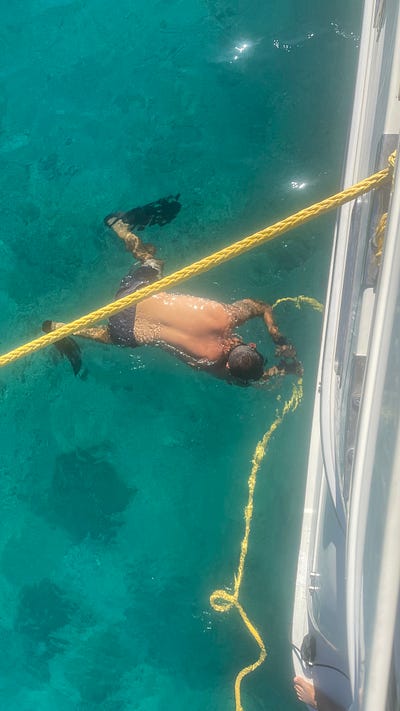

As I sit here writing, we’re in “One House Bay” on Atokos — a stunningly beautiful island with pigs on the beach and crystal clear water. There were few charters to be seen (Saturday so they are back at base doing handovers) and we thought we might stay an extra night here as well.
Then the swell kicked up overnight and we decided this morning we’d head back towards the mainland to a couple of very calm bays, off the charter route to relax and recuperate!
It’s a bit like that with boat life. Days of enjoyment with moments of intense frustration thrown in. The key is preparing for and where possible avoiding the bad times and making sure you make the most of the good.
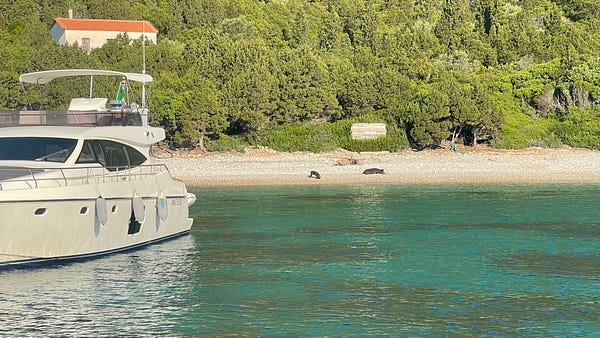
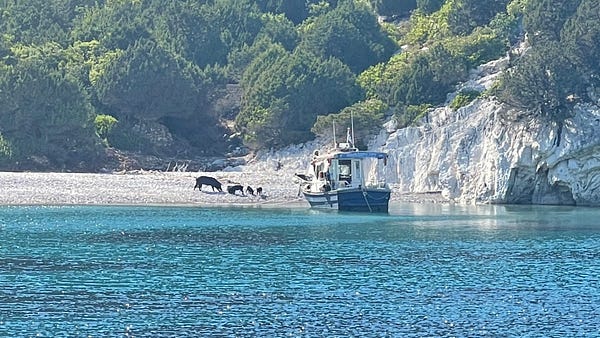
This week it’s a quiet week (we hope) heading away from the charter routes and slowly working north towards Lefkada where we will be next week and then head off on holidays to Germany and Edinburgh for a while and Matilda can get a bit of TLC and a few things checked out (including having a mechanic just double check the shaft and prop for us).
Want to see where we are, or check where we’ve been? Check us out on NoForeignLand https://www.noforeignland.com/boat/matilda
Until next time
Tim & Karina
